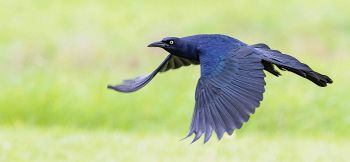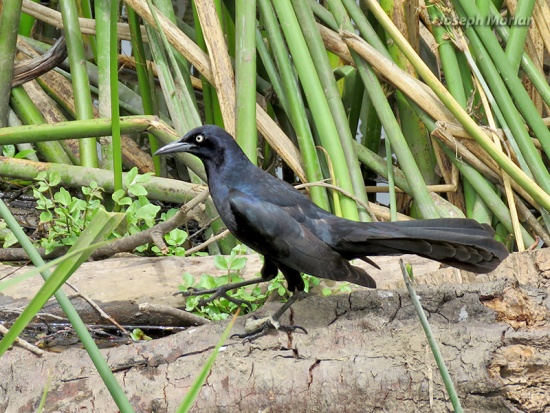- Quiscalus mexicanus
Identification
A large (40cm) totally black bird (M) with a long, sharp bill and an impressively long tail that is held vertically in flight, like a boat rudder. The yellow eye is diagnostic. The plumage of the male shows many colors in sunlight due to iridescence; blues and greens predominate.
The female is brown with lighter underparts, and with a shorter tail.
Similar Species
On Gulf Coast, can be distinguished from Boat-tailed Grackle by eye color.
Distribution

Photo © by Stanley Jones
Galveston Island, Galveston, Texas, USA, 4 May 2021
In the United States found from southern California east to Iowa south to Louisiana. Also found throughout Mexico and Central America south to Peru. Continues to expand range including into Northern California.
Taxonomy

Veterans Park and Athletic Complex, College Station, Brazos County, Texas, April 2024
Formerly lumped with Boat-tailed Grackle
Subspecies
This is a polytypic species consisting of eight subspecies[1]:
- Q. m. nelsoni:
- South-eastern California to southern Arizona and western Mexico (north-eastern Baja California and southern Sonora)
- Q. m. monsoni:
- Q. m. prosopidicola:
- South-eastern New Mexico to southern Texas, Coahuila, San Luis Potosí and southern Tamaulipas
- Q. m. graysoni:
- Coastal north-western Mexico (Sinaloa)
- Q. m. obscurus:
- Coastal south-western Mexico (Nayarit to Guerrero)
- Q. m. mexicanus:
- Q. m. loweryi:
- Coastal Yucatán Peninsula, Belize and adjacent offshore islands
- Q. m. peruvianus:
- Pacific coast of Costa Rica to north-western Peru and north-western Venezuela
Habitat
They can be found in a wide variety of habitats; marshes, wetlands, hill bushy areas, golf courses, gardens, and shopping malls.
Behaviour
In hot areas they will drink from any water available including swimming pools, and they may even take a voluntary swim!
They are social, particularly at dusk when they gather in sizeable flocks to roost in trees.
Diet
Great-tailed grackles frequent urban landscapes, often feeding in highly-developed areas such as parking lots. They will eat almost anything.
Vocalisation
They can be noisy, especially during breeding displays, when the male issues loud calls at what looks to be great physical effort.
Listen to a voice clip
Recording © by Joseph Morlan
Pacifica, California, 26 April 2020
References
- Clements, J. F., T. S. Schulenberg, M. J. Iliff, S. M. Billerman, T. A. Fredericks, B. L. Sullivan, and C. L. Wood. 2019. The eBird/Clements Checklist of Birds of the World: v2019. Downloaded from http://www.birds.cornell.edu/clementschecklist/download/
- BirdForum Member Observations
- Johnson, K. and B. D. Peer (2020). Great-tailed Grackle (Quiscalus mexicanus), version 1.0. In Birds of the World (A. F. Poole and F. B. Gill, Editors). Cornell Lab of Ornithology, Ithaca, NY, USA. https://doi.org/10.2173/bow.grtgra.01
- Fraga, R. (2020). Great-tailed Grackle (Quiscalus mexicanus). In: del Hoyo, J., Elliott, A., Sargatal, J., Christie, D.A. & de Juana, E. (eds.). Handbook of the Birds of the World Alive. Lynx Edicions, Barcelona. (retrieved from https://www.hbw.com/node/62287 on 2 May 2020).
Recommended Citation
- BirdForum Opus contributors. (2024) Great-tailed Grackle. In: BirdForum, the forum for wild birds and birding. Retrieved 27 July 2024 from https://www.birdforum.net/opus/Great-tailed_Grackle
External Links
GSearch checked for 2020 platform.1






